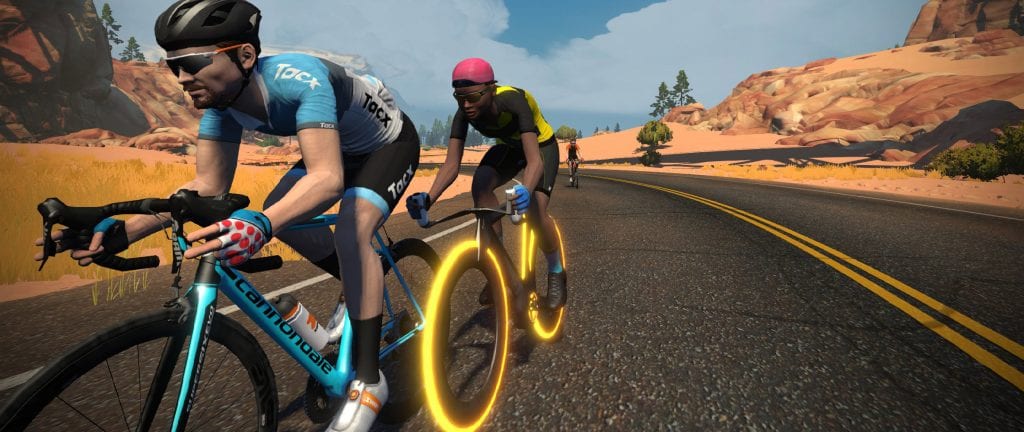With the Northern Hemisphere winter in full force, we’re seeing lots of new Zwifters on course. Many have little or no experience riding with power–that is, measuring wattage output and understanding how watts affect speed in solo and group ride situations.
Fortunately, Zwift behaves very much like the real world in terms of physics, so any understanding you may have of outdoor cycling physics will translate to Zwift, and any additional understanding you may gain from Zwifting will transfer outside.
One common question people ask, especially in race situations, is “Why am I getting beat by people who are putting out lower watts per kilogram?”
There are several answers to this question, but first make sure you understand how Zwift is calculating your speed. Secondly, understand that watts per kilogram (w/kg), or power to weight ratio, is your current wattage (the power you’re putting into the pedals) divided by your body weight in kilograms.
Example: I weigh 84kg, so if I’m putting out 300 watts my w/kg is 300/84=3.57
Now, back to the question. Here are the two top reasons why you’re getting beat by people who are putting out lower watts per kilogram.
#1: You Aren’t Staying in the Draft
Drafting in Zwift results in a power savings of approximately 25% (more in large groups or with double draft.) In other words, all other things being equal, a drafting rider only needs to put out 75% of the power a non-drafting rider is putting out to maintain the same speed.
If you’re “in the wind” on the front or off the back of a group, you will need to hold much more power than those who are drafting.
Tools like kreuzotter.de’s calculator can give you good numbers here which reflect outdoor and Zwift physics quite well.
Example from kreuzotter.de: a 75kg rider holding 225 watts will travel at 35kph. Another 75kg rider will be able to hold their wheel putting out 25% less power, or 169 watts.
Note: you cannot draft in Zwift on a TT frame. Others may draft behind you, but you will not receive any draft benefit.
Read an in-depth discussion of Zwift’s draft, including tips and tricks.

#2: You’re a Lighter Rider on Flat Terrain
Watts per kilogram is a good pace metric for climbs, where gravity is the main thing slowing you down. But pure wattage is a better metric for flat roads because once you get moving on the flat your speed is mostly determined by wind resistance and your wattage.
Because of this, when we take drafting out of the equation on a flat course, a heavier rider will always be faster than a light rider when both are doing the same w/kg–because the heavier rider is putting out more watts. This is true outdoors as well.
Example from kreuzotter.de: a 60kg rider and a 80kg rider both hold 4w/kg on flat ground. How fast are they traveling?
- 60kg rider holding 240 watts travels at 37kph
- 80kg rider holding 320 watts travels at 39.5kph
The 60kg rider would need to hold 288 watts (4.8w/kg) in order to keep up with the 80kg rider, if drafting isn’t taken into the equation.
The One-Two Punch
Where things really get tough is when #1 and #2 above both apply to you. If you’re a lighter rider who gets dropped from the pack on a flat course, you’ll have to hold a much higher w/kg than the group in order to catch that group again!
Here’s a simplified example with numbers pulled from kreuzotter.de’s calculator: let’s say you are a 60kg rider racing in a pack being pulled by a 90kg rider who is putting out 360w (4w/kg). The pack would be traveling at 40.6kph. Since you are drafting, you only need to put out 75% of the 312w it would take you to travel that same speed solo. That’s 234w, which is 3.9w/kg. Don’t miss this! Just to maintain your position in the draft your w/kg must basically match the heavier rider who is pulling in the wind.
Then if you get dropped and lose the draft’s 25% power savings, you’ll need to put out 312w just to keep pace with the group. That’s a whopping 5.2w/kg, while the guy pulling in the pack is still just doing 4w/kg. Couple this with the fact that others in the group can rotate through and take pulls so everyone stays fresh, and you’re going to have a very hard time catching the pack in this situation!
The Takeaway
Just like riding outdoors, lighter riders will be challenged to keep up with heavier, more powerful riders on flat courses. Stay in the draft to conserve energy so you can use it when it counts. And remember: you’ll get ’em in the hills!

